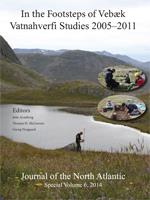Midden excavations at Ø172 (Tatsipataa), on the eastern shore of the Igaliku fjord in southwestern Greenland, produced a significant textile collection consisting of 98 fragments. This collection is important as it stems from a well-contextualized and well-stratified sequence, allowing significant insights into the evolution and nature of cloth production in Greenland. Analysis of this collection showed that while the earliest fragments mirror Icelandic counterparts of comparable ages, the Ø172 collection changes considerably by the 14th century. From this point onward, Greenlandic women wove a weft-dominant cloth unique to Greenland. This cloth type has previously been noted in other, later, Greenlandic collections, but the Tatsipataa collection provides new evidence for the date of its first production. The sudden appearance of this distinctive weft-dominant Greenlandic homespun in the mid-14th century suggests that its production was a domestic adaptation to the initial climatic fluctuations of the Little Ice Age. Overall, the Tatsipataa collection suggests that Greenlandic textile production did not follow the evolutionary trajectory of Icelandic textiles, which became a form of currency from the early to the later Middle Ages. Instead, Greenlandic textiles appear to have been consistently produced for household consumption, without the intense standardization for trade observed in medieval Icelandic collections.
How to translate text using browser tools
1 April 2014
Dress, Cloth, and the Farmer's Wife: Textiles from Ø 172 Tatsipataa, Greenland, with Comparative Data from Iceland
Michèle Hayeur Smith
ACCESS THE FULL ARTICLE
<
Previous Article
|

Journal of the North Atlantic
Vol. 2014 • No. sp6
2014
Vol. 2014 • No. sp6
2014




